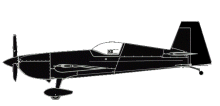
ASN Wikibase Occurrence # 186884
This information is added by users of ASN. Neither ASN nor the Flight Safety Foundation are responsible for the completeness or correctness of this information.
If you feel this information is incomplete or incorrect, you can submit corrected information.
| Date: | Saturday 30 April 2016 |
| Time: | 16:24 |
| Type: |  Extra EA-330LC |
| Owner/operator: | Sky Combat Ace |
| Registration: | N330MT |
| MSN: | 1316 |
| Year of manufacture: | 2011 |
| Total airframe hrs: | 776 hours |
| Engine model: | Lycoming AEIO-580-B1A |
| Fatalities: | Fatalities: 2 / Occupants: 2 |
| Aircraft damage: | Destroyed |
| Category: | Accident |
| Location: | near Henderson Executive Airport, NV (HND) -
 United States of America United States of America
|
| Phase: | Manoeuvring (airshow, firefighting, ag.ops.) |
| Nature: | Training |
| Departure airport: | Henderson Executive Airport, NV (HND) |
| Henderson Executive Airport, NV (HND) | |
| Investigating agency: | NTSB |
| Confidence Rating: |
The flight instructor and passenger, departed on a flight with two other airplanes to conduct simulated air-to-air combat maneuvers. Two airplanes at a time would maneuver against each other, while the other airplane observed from a higher altitude and safe distance. Examination of onboard video and audio recordings revealed that this portion of the flight was uneventful, however, following the series of aerobatic maneuvers, the passenger began experiencing air-sickness.
While returning to the airport, the airplanes flew a planned low-level flight (minimum altitude of 30 ft agl) in trail formation to simulate a bombing run. The accident airplane was the last airplane in the formation. During this time, the pilot communicated to the passenger, that he would fly the airplane "nice and easy." After climbing over a ridgeline, and descending back towards the desert floor, the airplane approached a small hill. Video indicated that the passenger, who was seated in the front seat, likely knew that a ground collision was imminent but was unable to communicate effectively with the pilot, since his microphone was out of position. The airplane subsequently impacted terrain near the top of the hill. The video showed the airplane flying at a normal speed and attitude before the impact occurred, with no indication of an evasive maneuver. Postaccident examination of the airplane revealed no evidence of mechanical malfunctions or failures that would have precluded normal operation.
Although the airplane encountered precipitation during the low-level portion of the flight, the precipitation did not appear to reduce forward visibility or obscure the terrain. However, the tandem seating configuration of the airplane made it difficult for the rear-seated flight instructor to see the areas directly in front of and below the airplane. As such, pilots normally conducted "check turns" during low-level operations to ensure obstacle and terrain clearance. Video from the accident airplane and another airplane in the formation indicated that the accident pilot performed 4 check turns during the approximate 2-minute low-level flight; the other pilot performed 8 check turns during this time. It is likely that the accident pilot intentionally conducted fewer check turns, to clear for terrain and obstacles, because of the passenger's airsickness.
Toxicology testing of the pilot detected tetrahydrocannabinol (THC, the primary psychoactive component of marijuana) in tissue sample; however, because the antemortem blood levels of THC could not be directly computed and because there is no direct relationship established between blood levels of THC and impairment, whether the pilot's use of marijuana contributed to the accident could not be determined from the available evidence.
Probable Cause: The pilot's failure to monitor and maintain clearance with terrain while maneuvering at low level. Contributing to the accident, was the pilot's failure to conduct an adequate amount of clearing turns while maneuvering at low level.
Accident investigation:
 |
|
Sources:
NTSB
FAA register: http://registry.faa.gov/aircraftinquiry/NNum_Results.aspx?NNumbertxt=330MT
Location
Images:



Photos(c): NTSB
Revision history:
| Date/time | Contributor | Updates |
|---|---|---|
| 01-May-2016 01:36 | Geno | Added |
| 01-May-2016 13:42 | Poldi | Updated [Aircraft type, Operator] |
| 01-May-2016 13:44 | harro | Updated [Aircraft type, Registration, Cn, Source] |
| 01-May-2016 14:08 | harro | Updated [Time, Phase, Departure airport, Source, Narrative, Photo, ] |
| 01-May-2016 15:45 | Geno | Updated [Phase, Nature, Departure airport, Destination airport, Source, Narrative] |
| 01-May-2016 17:00 | Alpine Flight | Updated [Time, Aircraft type, Damage] |
| 02-May-2016 15:21 | Geno | Updated [Source, Narrative] |
| 07-May-2016 14:30 | Aerossurance | Updated [Location, Source] |
| 21-Dec-2016 19:30 | ASN Update Bot | Updated [Time, Damage, Category, Investigating agency] |
| 22-Jul-2018 18:49 | ASN Update Bot | Updated [Time, Operator, Nature, Departure airport, Destination airport, Source, Damage, Narrative] |
| 11-Mar-2022 15:47 | Captain Adam | Updated [Location, Departure airport, Destination airport, Source, Narrative, Photo] |
| 11-Mar-2022 15:48 | Captain Adam | Updated [Photo] |
Corrections or additions? ... Edit this accident description
The Aviation Safety Network is an exclusive service provided by:


 ©2024 Flight Safety Foundation
©2024 Flight Safety Foundation